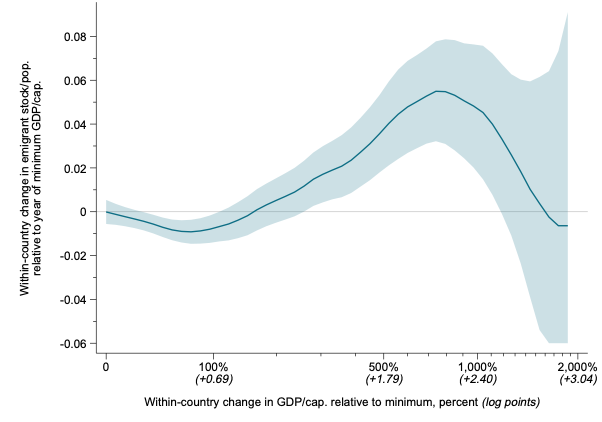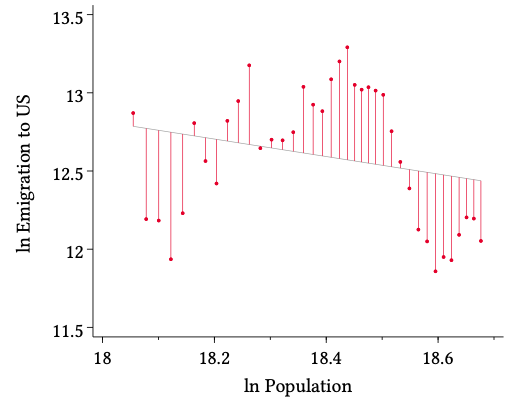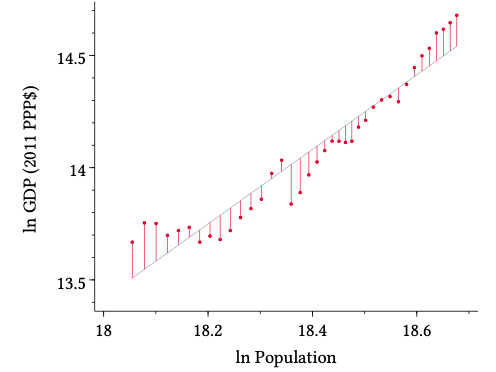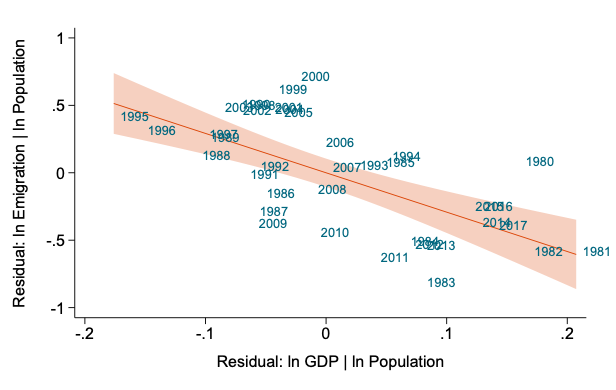Recommended
To reduce immigration pressure, many governments have turned to development assistance. The argument goes like this: use aid to create more economic opportunity in the low-income countries where migrants come from. Who could deny that rising opportunity at home would give them fewer reasons to leave?
Well, the facts do. The facts deny that. Within low-income countries, richer people are more likely to emigrate. And as low-income countries economically grow, people are more likely to emigrate.
But we shouldn’t use a fear of migration as a reason to keep poor countries poor. That would ignore the inherent value of poverty reduction, as well as harm donor countries’ own interests in a prosperous, healthy, and stable world. Rather, these facts matter because development policy that is not based on facts never works. Development assistance should engage with human mobility—not to deter it, but to shape it for mutual benefit.
We shouldn’t use a fear of migration as a reason to keep poor countries poor.
Today, I released two major research papers that document and explore the empirical relationship between rising incomes within, and emigration from, low-income countries. One of these papers studies households within low-income countries, and is joint research with Professor Mariapia Mendola (University of Milan Bicocca and Institute of Labor Economics, Bonn). The other paper looks at the national level over the past 200 years.
The papers culminate years of work. So, a short blog post is not going to happen. Buckle up.
Within low-income countries, richer people are more likely to emigrate
In the first paper, Mendola and I looked at people actively preparing to emigrate from 99 low- and medium-income countries. These are people who are not just hoping or planning to emigrate, but have taken costly steps to prepare for emigration, such as paying for travel. We compare their incomes to the incomes of people who are not preparing to emigrate. We used nationally representative survey data from 653,613 people, collected by the premier Gallup World Poll between 2010 and 2015.
Below is one slice of the data, showing 120,420 people in low-income countries, like Mali, Ethiopia, and Laos. The horizontal axis shows how far each person is above or below national average income, on a logarithmic scale. Zero means average. The orange bell-shaped curve is the distribution of income; the higher the curve, the more people there are at that income level. The blue line is the probability that people at that income level are currently, actively preparing to emigrate. The shaded blue band around the line shows a 95 percent interval of statistical confidence.

On average, people with higher incomes are much more likely to be actively preparing to emigrate. People earning triple the average income in a low-income country (1.1 log points above 0) are about twice as likely to be preparing to emigrate as people earning a third of the average income (1.1 log points below 0).
This means two striking things. First, it means that as poorer people gain more economic opportunity, they will be more likely to leave their home country. Second, it means that such additional emigration will be what economists call “positively selected” on the determinants of earnings. As incomes rise, these new emigrants will be more endowed with the things that make them more productive wherever they go, like schooling and natural talent.
In the paper we check this result in numerous ways. Actively preparing to emigrate is not the same thing as actually emigrating, but scholars have confirmed that the numbers of people actively preparing to migrate line up closely with independent data on subsequent, actual migration. And the surveys show that relatively richer people are better able to turn their plans into reality at each step of the emigration process. So, the real upward slope of that blue line could be even steeper. We also offer independent evidence that this pattern does not greatly differ in irregular versus regular migrants, as other research has shown with samples of irregular migrants who may or may not be representative. And we present data separately for each of the 99 countries, showing that the pattern is not driven by a few unusual countries. Similar patterns are close to universal across low-income countries.
How common sense can go astray
Many people find that rising blue line hard to believe. Why would people with more economic opportunity at home be less likely to stay there?
It helps to think of migration as an investment that migrants make in their future.
It helps to think of migration as an investment that migrants make in their future. Consider a similar investment: getting a college education. Relatively richer people have less “need” for the higher earnings that come from a college education. Therefore, they must be relatively less likely to bother getting one. But that’s the opposite of what happens. Growing up with higher incomes typically raises both the aspirations and ability of young people to invest in college.
Similar forces are at work in migration. For example, one of the first things that poor families invest in as they get more economic opportunity is more and better schooling for their children. People with more and better schooling tend to have greater aspirations and ability to emigrate. Rising education is a major reason for the shape of the blue line. But it wouldn’t make sense to examine the effect of rising incomes holding education constant, which would amount to asking how rising income would affect emigration if income didn’t affect education. It does, almost everywhere. All of this means that the correlation between income and emigration within groups of people, like those defined by education levels, can be the opposite of the correlation in the broader population. This is such a common logical pitfall that it has a name: Simpson’s Paradox.
As low-income countries economically grow, people are more likely to emigrate
Personal income, of course, is not the same as national income. The above findings show that when some people get relatively richer, they are more likely to emigrate. But what will they do if everyone gets richer?
My second paper looks at the country level. As entire economies develop, what happens to their collective rate of emigration? I’ve been interested in these patterns for a long time, writing this paper off and on since a seminar I gave at the Center for Global Development in 2011.
In brief, the emigration rate first rises, then falls, as poor economies grow.
In brief, the emigration rate first rises, then falls, as poor economies grow. This striking pattern was named the emigration life cycle by economic historians Tim Hatton and Jeff Williamson. It is most obvious if you simply look across countries, as in the graph below.
The graph looks at all low- and middle-income countries between 1960–2019. The horizontal axis shows real gross domestic product (GDP) per capita. The vertical axis shows the emigration rate, or the number of people born in each country living outside it, as a fraction of the home-country population. The line is a moving average, and the shaded blue band is an interval of 95 percent statistical confidence.

In the poorest countries, on average just 4 percent of the population lives abroad. For countries that have successfully developed to a GDP per capita of around US$10,000 (measured at US prices, think Jordan and the Philippines), you might think emigration should be lower. People there have vastly more economic opportunity at home. But for them, emigration is almost triple the value in the poorest countries. It is over 11 percent. Only for countries that are even richer does emigration tend to be lower.
You might wonder if the pattern above actually reflects the path that any given country will follow as it develops. Maybe not. In the graph above, there may be something coincidentally different about the poorest countries that would make emigration from there relatively low. They might happen to be located far from major migrant destinations, for example, or start out with smaller diasporas.
Therefore, the graph below traces out the average path actually followed by countries that started out as low-income (roughly less than $2,000 GDP per capita), and then grew richer. Where the above graph compared the level of income to the level of emigration, the one below compares the change in income over time to the change in the emigration rate. This one compares economic growth and net emigration flows. This removes the confounding effects of anything that does not change over time, like geographic location or initial diaspora size.

The emigration life cycle looks almost the same within countries over time as it does across countries. In the earlier graph, which pools together all countries and years, countries 10 times richer than the poorest low-income countries have an emigration rate about 7 percentage points higher. In this graph immediately above, as once-poor countries get ten times richer than they used to be, their average emigration rate rises about 5 percentage points. So, conservatively, at least two thirds of that sharp rise in the first graph represents the average path that once-poor countries took as they developed. The paper shows that this pattern holds even if one discards small countries of migrant origin, or poor countries of migrant destination. The pattern is one of the most robust I’ve seen in any studies of the development process.
This work confirms, with the approach of quantitative economics, what a range of other social scientists have consistently found with more granular and contextual methods
This work confirms, with the approach of quantitative economics, what a range of other social scientists have consistently found with more granular and contextual methods. Sociologist Doug Massey of Princeton concluded that “emigration is a normal by-product of economic development.” Sociologist Hein de Haas has been pointing this out for many years, as have geographers from Ron Skeldon to recent work by Jørgen Carling and Cathrine Talleraas. For typical poor countries, development is not a substitute for emigration; emigration is a feature of development.
For typical poor countries, development is not a substitute for emigration; emigration is a feature of development.
Why does it happen?
In principle, these patterns could be driven by policy barriers. Maybe people from the poorest countries simply cannot get visas to go live abroad, and people from richer countries can.
Let’s look at a real setting without substantial policy barriers: European emigration to the New World in the decades leading up to World War I. 81 percent of those migrants went to just three countries: the United States, Canada, and Argentina. So, we can measure emigration to those countries by counting, for example, Hungarians in the US census at the time and comparing that to the population of Hungary.

The graph on the left compares the level of emigration to the US to the level of income at home, pooling all countries of migrant origin between 1850 and 1910. The graph on the right compares net emigration flows to income growth, within countries that started out very poor. The emigration life cycle is strikingly similar. The main difference we see today is that the turning point arrives at a lower absolute level of GDP per capita. That makes sense, because the richest countries in the world at this time only had a GDP per capita in today’s dollars of around $6,500. The pattern looks very similar for emigration to Canada or Argentina.
The emigration life cycle has been a strong feature of development for two centuries, and the reasons for it have not fundamentally changed.
Policy barriers are therefore unlikely to be responsible for a large part of today’s emigration life cycle. In the paper, I look at what is. Three big forces—rising education, demographic shifts, and structural change from an agricultural to an urban economy—explain a large part of the pattern. The emigration life cycle has been a strong feature of development for two centuries, and the reasons for it have not fundamentally changed.
How statistics can go astray
The emigration life cycle is controversial. Many governments are deeply invested in the idea that development simply must deter migration, and that powerful intuition understandably makes them look askance at data. Another reason is that in statistical analysis, it is easy for even the most skilled analysts to slip up and mistakenly claim to show a different pattern.
Such an error occurred in a recent working paper from the Kiel Institute for the World Economy, in Germany. That paper measures the relationship between economic growth and emigration flows from low-income countries to OECD countries, between the mid-1980s and 2015. It finds that as an average poor country’s income doubles, its emigration rate collapses—falling by half. The paper calls this “the true relationship between economic development and emigration.”
But this result is an artifact of poor method. The paper makes a statistical oversight that has been known for at least a century, and was named the “spurious regressions” problem by Nobel laureate Clive Granger.
The Kiel Institute paper compares rising emigration to rising GDP, controlling for rising population. At first glance, that seems like an acceptable way to see how emigration changes with GDP per capita. But the method contains a fatal flaw. Doing the analysis in this way removes the effect on emigration due to any sustained rises in GDP. That is, it removes the entire effect of economic development, the effect it seeks to measure. When one controls for population (and a constant term) in a statistical regression of this kind, all that remains to be measured in the relationship between GDP and emigration is the effect of short-term shocks to GDP, such as those that happen in an economic crisis or a war. Those do not measure economic development at all.
My paper shows the math behind this, but it is easy to demonstrate in pictures. Start with a country that is the poster child of the emigration life cycle: Mexico. There, emigration rose with development, and has recently fallen at relatively high levels of GDP per capita.

Watch what happens when we apply the flawed method described above to exactly the same data. First regress emigration on Mexico’s population, and take the residuals (the red lines in the figure below).

Now take Mexico’s GDP, and regress that on the population, again taking the residuals.

When we regress emigration on GDP, controlling for population (with everything in logarithms), what we are doing is precisely regressing the first set of residuals, above, on the second set. Here is what that regression looks like.

The relationship between these residuals is negative, large, and highly statistically significant. This is the coefficient being measured in the Kiel Institute paper.
But it is also entirely spurious, having no relation to Mexico’s “economic development.” What the above graph shows, for example, is that during a short-term negative shock like the “Peso Crisis” recession of the mid-1990s, emigration was high relative to the population. But that deviation contains no information about the overall economic development of Mexico—the sustained rising trend in Mexico’s GDP. That trend is the line in the GDP-population plot above that has been removed from the numbers used to estimate the spurious relationship. The correct relationship between economic development and emigration in Mexico, when Mexico was poor, was the unmistakable rise in the initial stages of the emigration life cycle.
In my paper, I show how correcting that error eliminates any substantive disagreement about how emigration changes as poor countries initially experience sustained economic growth. The evidence could not be clearer; there is no meaningful controversy. The emigration life cycle is a striking feature of the development process, one that aid agencies must grapple with if they wish their actions to be effective.
Foreign aid can engage with migration far beyond deterrence
Many governments have declared that a central goal of their development assistance is to deter emigration from low-income countries. Since 2016, the US has appropriated $2.6 billion for Central America, primarily to “promote economic prosperity” in order to “address the root causes of migration.” Responding to a spike in migrant arrivals in 2015, the European Union created a €4.7 billion Trust Fund to address the “root causes” of migration, in part by creating “economic opportunity” in Africa.
These policies rest on a core assumption: that rising economic opportunity in poor countries typically deters emigration, as Hannah Postel (Princeton University) and I have pointed out. That assumption has no basis. Precisely the opposite has been, and is, true.
Again, we should not use a fear of migration as a reason to keep poor countries poor. The emigration life cycle doesn’t imply that aid shouldn’t exist, but that the repurposing of development assistance as a way to stop migration has always been a political project with little hope of generalized real-world success.
Development assistance should engage with human mobility; not to deter it, but to shape it for mutual benefit.
Instead, development assistance should engage with human mobility; not to deter it, but to shape it for mutual benefit. It should seek to address the shocks that spur increased emigration, like conflict, violence, climate change, and economic collapse. It should work to reduce smuggling and trafficking, making journeys safer and cheaper. And it should support new legal immigration pathways like asylum, refugee resettlement, family reunification, and work visas. Indeed, strengthening those pathways requires development assistance, because they require migrant origin countries to work in partnership with migrant destination countries.
The latter, in particular, can be designed in a way that increases economic development in both migrant sending and receiving countries, plugging skills gaps, and facilitating safe, orderly, and regular migration. Our Global Skill Partnership model is one way to do this, among countless other innovations. Development assistance, therefore, should not stay away from human mobility. It should recognize that economic development and emigration often go hand in hand, and engage with this reality.
Disclaimer
CGD blog posts reflect the views of the authors, drawing on prior research and experience in their areas of expertise. CGD is a nonpartisan, independent organization and does not take institutional positions.
Image credit for social media/web: Hencer Oliva/Adobe







